How to Do the Barbell Skull Crusher for Triceps Size and Strength
The barbell skull crusher, also known as the barbell triceps extension, is one of the most well-known exercises for the triceps. Yet it is heavily underrated due to a misunderstanding of how to perform the exercise effectively.
The barbell skull crusher can improve strength in a variety of activities, especially the bench press and overhead press. When performed correctly, the exercise takes your triceps through a range of motion that will ignite your muscle-building potential and challenge the triceps in a way that few exercises can.
- How to Do the Barbell Skull Crusher
- Barbell Skull Crusher Mistakes to Avoid
- Benefits of the Barbell Skull Crusher
- Muscles Worked by the Barbell Skull Crusher
- Who Should Do the Barbell Skull Crusher
- How to Program the Barbell Skull Crusher
- Barbell Skull Crusher Variations
- Barbell Skull Crusher Alternatives
- Frequently Asked Questions
How to Do the Barbell Skull Crusher
Skull crushers may seem like a simple movement, but lifters don’t often optimize their position to get the most triceps growth for their buck. By applying simple changes to your body position, you can facilitate even more muscle growth while reducing strain on the elbow and shoulder joints.
Here’s what you need to know to perfect the movement and unlock its potential.
Step 1 — Get Into Position
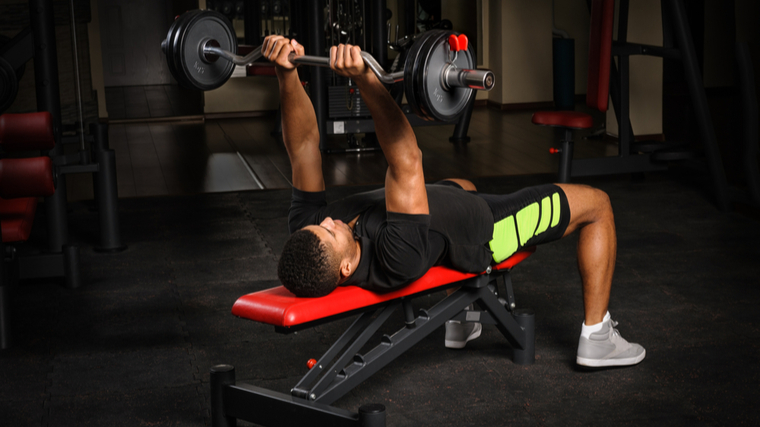
Lie on a flat bench with a barbell held over your chest in a shoulder-width, palms-down grip, the same way you would when performing a bench press. If you have a training partner, they can help you get the bar into the starting position. If you’re training alone, you can use the bench press pins or “kick” the bar into position with your knees as you lie on the bench.
Limiting any arch of the lower back will help to create a more disadvantaged position for the triceps, meaning that the muscle will have to work harder. And working harder means you will build more size and strength.
Form Tip: Focus on keeping a “grounded” and fully engaged torso with no arch in your lower back. You can place your feet on the bench to focus on limiting torso extension.
Step 2 — Lower the Weight to a Full Stretch
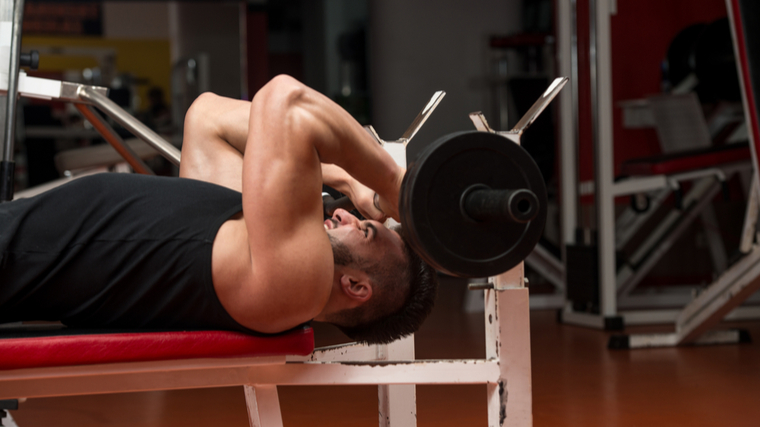
Lower the barbell towards your forehead. This is where the “skull crusher” exercise gets its melodramatic name.
As you reach roughly the halfway point, slightly shift your elbows towards your head to maximize the stretch on the triceps. Just don’t let them move too far back, which would recruit your lats instead of emphasizing your triceps.
Form Tip: Range of motion is key here. Feeling the triceps stretched to their fullest will tell you if you have performed this part of exercise correctly. It is important to not relax the muscle and let the weight strain the joints at the bottom. Make a conscious effort to actively contract the triceps.
Step 3 — Extend Your Arms to Raise the Weight
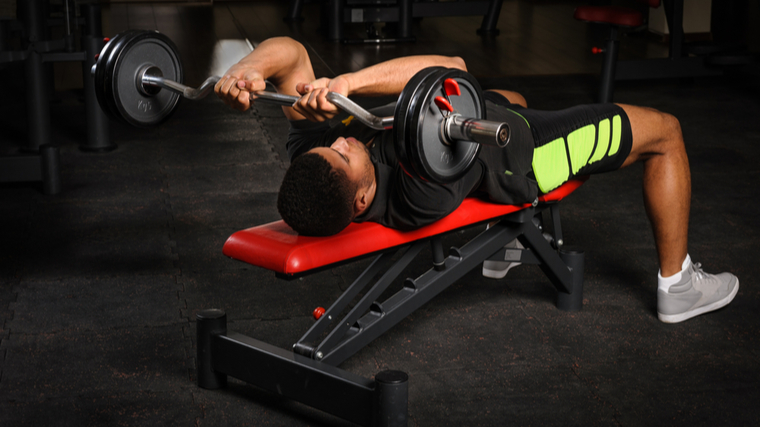
Pause briefly in the fully stretched position before powerfully contracting your triceps to extend your arms. “Lift explosively, lower under control” is an effective way to approach both portions of this exercise.
In the top position, your arms should be locked out with the bar above your forehead, not your chest. This helps to maintain constant tension and can lead to more growth. With skull crushers, and many muscle-building movements, tension is the name of the game.
Form Tip: Keep your elbows steady while raising the weight. Focus on getting the weight up by flexing your triceps and driving your hands through the bar. In the lockout position, your triceps should still be under tension, not relaxed.
Barbell Skull Crusher Mistakes to Avoid
Smooth and strong execution is the key to make sure you’re actually targeting the triceps with skull crushers. Too often, lifters worry so much about moving heavy weights that they end up swinging their upper body and taking work away from the triceps.
Elbows Flaring Out
The primary function of the triceps is to produce elbow extension, or straightening of the arms. To do this, you want the elbows to be stable when performing barbell skull crushers. This allows a greater connection with the triceps without displacing stress to other muscles or providing added stress to the joints.
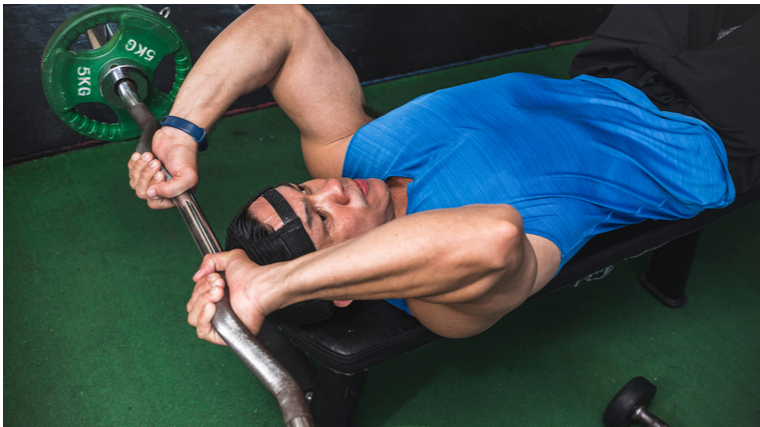
If your elbows flare out, then you lose the ability to maximize the tension placed on the triceps. You also place the delicate elbow joint into an unstable load-bearing position which can lead to pain and injury.
Avoid It: Maintain a strong abdominal brace and control your breathing pattern. This increases stability as a whole, from your torso through your arms, which will allow greater control when performing the movement. Choosing an appropriate weight and simply executing reps with controlled form is also essential.
Unstable Torso
Even though you’re lying on a flat bench, the torso plays a surprisingly large role when performing the barbell skull crusher. Some lifters allow their hips to shoot up, which leads to instability through the torso via extension (when you create a large arch in your lower back).
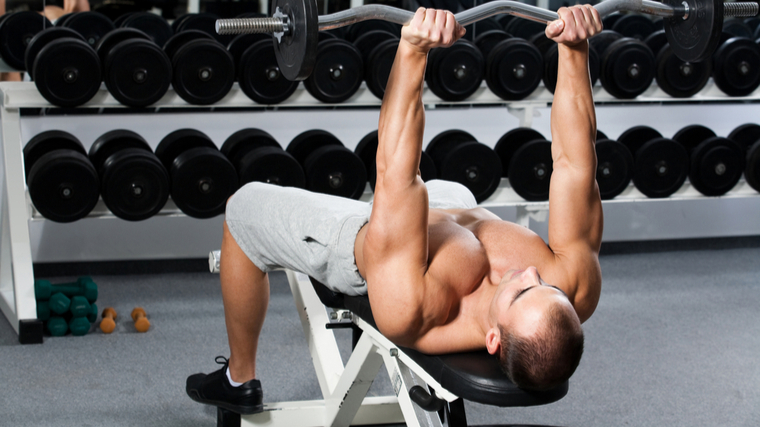
This will affect efficiency in recruiting your triceps because your shoulders and elbows are then shifted backwards, which causes the entire upper body to become unstable. This also turns the movement into a pullover variation, which puts more work onto the lats and serratus instead of the triceps.
Avoid It: Elevate your feet onto the bench or move the bench near a wall and place your feet on the wall during the set. This uncommon solution allows you to keep your torso in contact with the bench and be more stable, which enhances your ability to maintain tension on the triceps with increased stability from head to toe.
Benefits of the Barbell Skull Crusher
Some lifters choose to minimize or entirely overlook direct triceps exercises, like the barbell skull crusher. This approach to training is often based on the time-efficient but arguably effective system of relying on the triceps’ role as assistant muscles during larger exercises, such as presses, to provide sufficient stimulus.
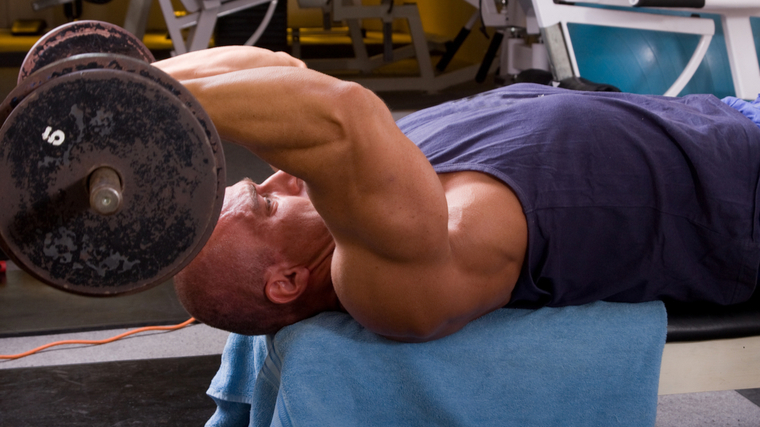
Targeting the triceps directly with the barbell skull crusher can deliver greater overall results due to the increased muscle activation during the exercise.
Increase Lockout Strength
The triceps are responsible for complete elbow extension during upper body pressing movements such as the bench press or overhead press. The barbell skull crusher plays a huge role in developing your ability to successfully lockout each rep. Any lifter focused on improving these heavy lifts will see greater improvements and fewer weak points when implementing skull crushers into their program.
Build Bigger Arms
For some lifters, the goal of training is just to build a solid set of pipes. The triceps take up two-thirds of the upper arm, compared to the relatively smaller biceps, which means giving the triceps plenty of attention is a surefire way to increase arm size. The barbell skull crusher targets all three heads of the triceps for complete development.
Muscles Worked by the Barbell Skull Crusher
The barbell skull crusher primarily targets all three heads of the triceps muscle, with specific recruitment of the long head due to shoulder position during the exercise.

Triceps Brachii
The triceps brachii are “the triceps” on the back of the upper arm. It consists of three separate heads — the long, lateral, and medial — which function together to extend the arm. All three heads connect to the forearm bone, but only the long head attaches to the scapula while the other heads attach to the humerus (upper arm).
Because the long head crosses the shoulder joint with this unique attachment, it is emphasized when performing the barbell skull crusher (or any time the upper arm is involved in an exercise).
Who Should Do the Barbell Skull Crusher
No lifter should neglect this beneficial exercise. Its usefulness can specifically aid many other movements throughout your week of training.
Training for Strength and Power
Because the barbell skull crusher strengthens the triceps and improves lockout strength, lifters seeking to increase their bench press or overhead press will benefit greatly from adding skull crushers to their programming.
Training for Muscle
When a lifter’s goal is building bigger arms, the barbell skull crusher should be prioritized. The complete muscle recruitment of the triceps, with specific emphasis on the long head, influences muscle growth unlike many other triceps exercises.
How to Program the Barbell Skull Crusher
The triceps have been shown to have a high degree of type II muscle fibers. These “fast-twitch” fibers allow the triceps to respond exceptionally well to explosive-type power training and heavy lifting. (1)(2) . However, to recruit all muscle fiber types for optimal development, using a mix of rep ranges has been shown to be best. (3)
It is important to note that the triceps are activated during horizontal and vertical pressing movements, with horizontal presses (like the bench press) recruiting more triceps compared to vertical presses (like the shoulder press). (4) The inclusion of isolation exercises like the barbell skull crusher will be necessary to fully stimulate the triceps for maximum results.
Higher frequency training has been shown to be more effective than lower frequency work. (5) Start with training the triceps twice per week and slowly graduate to three days per week for maximum growth.
Moderate Weight, Moderate Repetition
On days when you perform overhead pressing (shoulder) exercises, which recruit the triceps to a lesser degree, perform the barbell skull crusher for three or four sets of 10 to 12 reps to maximally activate the triceps. This approach is best complemented by training triceps in an additional workout using a different set and rep range for improved overall results.
Lighter Weight, Higher Repetition
Two to four days after the first workout, ideally on a day you incorporate horizontal (chest) pressing exercises, train triceps using three or four sets of 12 to 20 reps. This diverse stimulus allows sufficient recovery from the previous workout. Pairing lighter weight, higher-rep triceps training with relatively heavy chest exercises also helps to reduce strain on the elbow joints.
Working the triceps multiple times per week using a variety of sets, reps, and loads is an almost-perfect way to build bigger, stronger triceps in a safe and effective manner.
Barbell Skull Crusher Variations
Many beginners jump right into exercises that require a certain level of technique. While the barbell skull crusher is not super-technical, it does involve some specific considerations to maximize the recruitment of the triceps. Learning effective variations may be more appropriate for lifters having trouble with the barbell movement or lifters looking for variety.
Resistance Band Skull Crusher
Use the same body position and flat bench setup as the barbell skull crusher with one small difference. Wrap a resistance band under the head side of the bench or around a heavy barbell on the floor.
Lie down and grab the band with your palms facing the ceiling. Begin from the stretched position and extend your arms overhead.
Flat Bench Cable Triceps Extension
Set a bench in front of a cable machine. Attach an angled bar to the lower pulley. Lie on the bench with your head nearest the cable and perform a skull crusher, starting from the bottom position to full lockout.
This variation is a great opportunity to practice the entire technique before getting yourself under some heavier loads. Also, the cable provides more constant tension on the muscle since it’s taut throughout the entirety of the exercise’s range of motion.
Dumbbell Skull Crusher
Lie back onto a flat bench with a pair of dumbbells. Begin with the weights above your chest, similar to a dumbbell bench press. Lower the weight under control towards your head, angling your hands inwards to touch the top of your shoulders.
Contract your triceps to fully extend your arms and begin lowering into the next rep. Once you can perform these with control, you will be ready to get yourself under the bar for some more intense skull crushers.
Barbell Skull Crusher Alternatives
The barbell skull crusher is one very effective type of triceps extension, but other triceps extension exercises can be useful for bulking up the triceps. Here are some great alternatives to consider based on your overall program and available equipment.
Overhead Extension
If you have good shoulder mobility and healthy elbows, overhead extensions will put your triceps into an even deeper stretch in the bottom position. This increased range of motion should stimulate even more muscle growth.
Cable triceps extensions are a great alternative to the barbell. The main differences are the loading (because cable exercise cannot be progressed as heavily as barbells) and the positioning of the upper arm.
Tricep Pressdown
Triceps pressdowns can be less stressful on the elbow joint than barbell skull crushers.
They won’t work your triceps through as deep of a stretch, which means the muscle-building stimulus may be reduced. The biggest advantage is that pressdowns tend to be easier on the elbows, especially if using a rope handle attachment.
Close-Grip Bench Press
Because the bench press is so conducive to higher loading, it’s a perfect choice for a triceps-focused heavy movement. Heavier loads have been shown to elicit higher levels of triceps activation, so this exercise is best programmed in a lower rep range. (6)
A shoulder-width grip produces more triceps activation than a wider bench press grip, and an inside-shoulder-width grip creates even greater triceps recruitment (7) However, such an extremely close-grip can provide unwanted strain on your wrists and limit the range of motion. For optimal results, use a shoulder-width grip to emphasize the triceps.
Time to Crush the Triceps
Barbell skull crushers will always be a mainstay in triceps workouts. The range of motion and muscle recruitment are nearly impossible to duplicate with other exercises. It improves your bench press and builds bigger arms. If those aren’t two of the most popular goals in the gym, then what are?
FAQs
How can I increase the weight used in this exercise?
A large part of moving heavier weights will stem from your ability to keep your torso stable through bracing. Tighten your stomach as if you were getting punched. This increases engagement of your entire core and helps to produce head-to-toe stability.
Increased stability allows you to more effectively manage each rep — lowering the barbell to the fully lengthened bottom position and making sure the triceps are contracting to move the barbell back up, not just waving your arms up and down.
An essential element in training is being able to produce the effort required for each rep. Most of the time, effort is the amount of weight being lifted. But never lose focus on your ability to maintain tension on the triceps. If you are not strong enough to keep your torso stable, then the tension shifts off of the triceps and you are left open to an injury or, worse, wasted time.
What do I do if my elbows hurt when performing skull crushers?
Complaints of discomfort and pain in the elbows are common during some triceps exercises, especially if the lifter has pre-existing joint problems. Overhead extensions are generally the most troublesome exercise, but skull crushers may still cause problems.
Performing your heavier pressing exercises first in your workouts will effectively warm-up your elbows before hitting skull crushers. The heavier work will also fatigue your triceps, leading to a reduction in weight used for skull crushers.
A lighter weight also allows a higher rep range. Remember, using heavy loads is not the most important training variable. Maintaining tension on the triceps and maximizing the range of motion can lead to greater benefits. If you have been performing 6-10 reps, move into 12-20 reps.
You can also use a different skull crusher variation. Instead of a straight barbell, try the EZ-bar to slightly adjust the wrist and elbow angle during the exercise. If that doesn’t help enough, use dumbbells or a cable variation, either with both arms or as single-arm exercises to strengthen each triceps individually.
References
- Talbot J, Maves L. Skeletal muscle fiber type: using insights from muscle developmental biology to dissect targets for susceptibility and resistance to muscle disease. Wiley Interdiscip Rev Dev Biol. 2016;5(4):518-534. doi:10.1002/wdev.230
- Terzis G, Georgiadis G, Vassiliadou E, Manta P. Relationship between shot put performance and triceps brachii fiber type composition and power production. Eur J Appl Physiol. 2003;90(1-2):10-15. doi:10.1007/s00421-003-0847-x
- Schoenfeld BJ, Grgic J, Van Every DW, Plotkin DL. Loading Recommendations for Muscle Strength, Hypertrophy, and Local Endurance: A Re-Examination of the Repetition Continuum. Sports. 2021; 9(2):32. https://doi.org/10.3390/sports9020032
- Barnett C, Kippers V, Turner P. Effects of variations of the bench press exercise on the EMG Activity of 5 Shoulder Muscles. 1995:222-227.
- Schoenfeld, B. J., Ogborn, D., & Krieger, J. W. (2016). Effects of Resistance Training Frequency on Measures of Muscle Hypertrophy: A Systematic Review and Meta-Analysis. Sports medicine (Auckland, N.Z.), 46(11), 1689–1697. https://doi.org/10.1007/s40279-016-0543-8
- Schoenfeld, Brad & Contreras, Bret & Vigotsky, Andrew & Ogborn, Daniel & Fontana, Fabio & Tiryaki-Sonmez, Raziye. (2016). Upper body muscle activation during low-versus high-load resistance exercise in the bench press. Isokinetics and Exercise Science. 24. 217-224. 10.3233/IES-160620.
- Lehman G. J. (2005). The influence of grip width and forearm pronation/supination on upper-body myoelectric activity during the flat bench press. Journal of strength and conditioning research, 19(3), 587–591. https://doi.org/10.1519/R-15024.1
Featured Image: Serghei Starus / Shutterstock
The post How to Do the Barbell Skull Crusher for Triceps Size and Strength appeared first on Breaking Muscle.
—————
TRANSCOM ISP – Free Sigma HSE Email
Level 6 Domain Names are FREE – Register Now.
